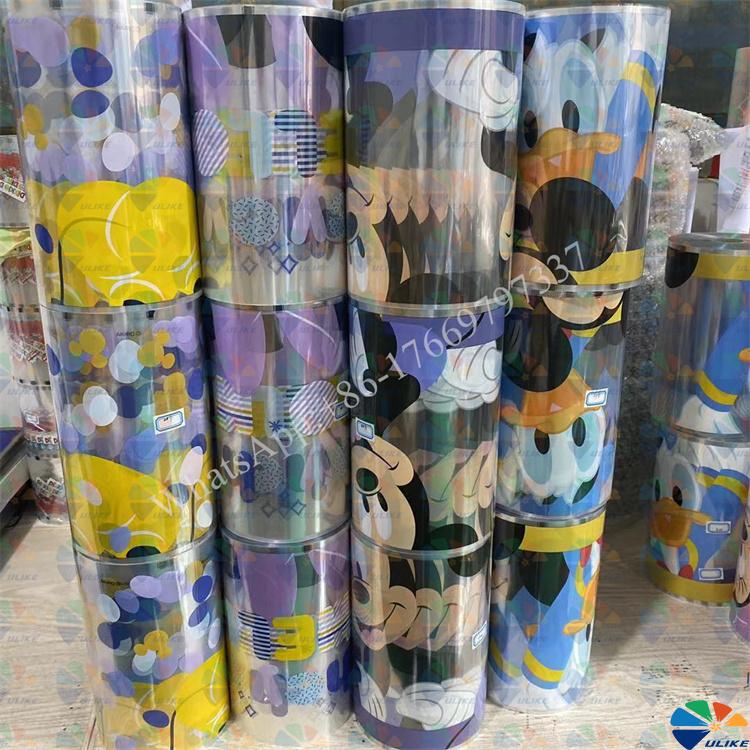Transfer film, what is thermal transfer film
Transfer film, what is thermal transfer film
1. What is
thermal transfer film
Thermal transfer film is a
necessary medium material in thermal transfer.
Thermal transfer is a technical form in which the pattern is first printed on the base film, printed into a thermal transfer film, and the pattern on the film is transferred to different substrates by heating and pressurizing using thermal transfer equipment.
2. Structure of thermal transfer film
Thermal transfer film is generally composed of four layers: substrate layer, release layer, printing layer, and glue layer.
1. Substrate layer: that is, the carrier coated with release agent, ink and adhesive, which requires the carrier to be heat-resistant, pressure-resistant and with small tensile deformation.
2. Release layer: a layer of release agent coating. The release agent is the key to complete the separation of the ink layer (pattern) from the substrate layer (base film) and transfer to the surface of the substrate. It requires good wear resistance, plays a role in protecting color ink, reducing the intensity of ultraviolet radiation, reducing the invasion of adverse factors in the air on ink, extending the service life of ink, and can buffer the adhesion of the substrate film and the printing layer.
3. Printing layer: The ink forms a pattern transferred to the surface of the substrate by air drying. That is, the ink is the basis for forming the printed pattern.
Thermal transfer uses gravure printing technology, and the printed pattern is colorful and bright. The quality of thermal transfer ink has a certain impact on the quality of the product. High-quality ink is green and environmentally friendly and meets international non-toxic standards.
4. Glue layer: Glue is an adhesive. Its basic performance is to have a high bonding force with the surface of the substrate to ensure that the printing layer is firmly bonded to the surface of the substrate. Products of different materials should choose different glues according to the material of the product.
Thermal transfer film structure diagram
Three, two major carriers of thermal transfer film
The carrier of thermal transfer film is the base film, which is generally made of PET and OPP.
1. PET: small elasticity and good stability. The most widely used. 80% of thermal transfer bottom films are made of this material.
2. OPP: It has greater elasticity and greater punching force, but poor high temperature resistance.
4. Production process of thermal transfer film
After the gravure plate is completed, the production stage of thermal transfer film begins. The production of thermal transfer film can be simply divided into 6 processes:
1. Blank film coating process: According to the process of thermal transfer film, the corresponding release agent and protective layer are coated. After ensuring that the release agent and protective layer are dried, the blank film is cut according to the specifications of the thermal transfer film to be printed;
2. Flower film pattern printing process: According to the established process of thermal transfer film, the gravure plate is installed on the gravure printing machine. After calibrating the overprint, the corresponding release film is installed on the gravure printing machine, and the printing of thermal transfer film is started, and various types of printing during the printing process are prevented. Problems, ensure that the ink layer is dry;
3. Adhesive glue coating process: After the thermal transfer film is printed, it goes to the adhesive glue coating process. According to the established process of the thermal transfer film, the printed thermal transfer printed film is coated with the corresponding adhesive glue, and the glue is ensured to be dried;
4. Re-inspection process of thermal transfer film: After completing the adhesive glue coating process, the re-inspection process of thermal transfer film is entered. The re-inspector re-inspects the thermal transfer film according to the established process and inspection requirements of the thermal transfer film, detects defective printing products, and ensures that the quality of the thermal transfer film is effectively controlled;
5. Thermal transfer film striping process: After the re-inspection is completed, the thermal transfer film will be striped. According to the established process requirements of the thermal transfer film, after determining the transfer direction, the thermal transfer film striping work is carried out;
6. Thermal transfer film packaging process: According to the packaging requirements of the thermal transfer film, after marking the relevant process, specifications, etc. of the thermal transfer film, the thermal transfer film is protected and packed. At this point, the production process of thermal transfer film is complete!
V. Storage of thermal transfer film
1. Handle with care;
2. Place vertically;
3. Place in a space below 25°C, away from heat sources;
4. Moisture-proof. Otherwise, chemical reactions will occur at high temperatures during hot stamping.
In short, when storing, pay attention to moisture-proof and pressure-proof, and place in a ventilated, cool and dry place.
![af]() Afrikaans
Afrikaans![sq]() Albanian
Albanian![am]() Amharic
Amharic![ar]() Arabic
Arabic![fr]() French
French![es]() Spanish
Spanish![ru]() Russian
Russian![de]() German
German![hy]() Armenian
Armenian![it]() Italian
Italian![ja]() Japanese
Japanese![ko]() Korean
Korean![pt]() Portuguese
Portuguese![hi]() Hindi
Hindi![az]() Azerbaijani
Azerbaijani![ro]() Romanian
Romanian![pl]() Polish
Polish![th]() Thai
Thai![el]() Greek
Greek![eu]() Basque
Basque![en]() English
English![zh-CN]() Chinese (Simplified)
Chinese (Simplified)![zh-TW]() Chinese (Traditional)
Chinese (Traditional)![be]() Belarusian
Belarusian![bn]() Bengali
Bengali![bs]() Bosnian
Bosnian![bg]() Bulgarian
Bulgarian![ca]() Catalan
Catalan![ceb]() Cebuano
Cebuano![ny]() Chichewa
Chichewa![co]() Corsican
Corsican![hr]() Croatian
Croatian![cs]() Czech
Czech![da]() Danish
Danish![nl]() Dutch
Dutch![eo]() Esperanto
Esperanto![et]() Estonian
Estonian![tl]() Filipino
Filipino![fi]() Finnish
Finnish![fy]() Frisian
Frisian![gl]() Galician
Galician![ka]() Georgian
Georgian![gu]() Gujarati
Gujarati![ht]() Haitian Creole
Haitian Creole![ha]() Hausa
Hausa![haw]() Hawaiian
Hawaiian![iw]() Hebrew
Hebrew![hmn]() Hmong
Hmong![hu]() Hungarian
Hungarian![is]() Icelandic
Icelandic![ig]() Igbo
Igbo![id]() Indonesian
Indonesian![ga]() Irish
Irish![jw]() Javanese
Javanese![kn]() Kannada
Kannada![kk]() Kazakh
Kazakh![km]() Khmer
Khmer![ku]() Kurdish (Kurmanji)
Kurdish (Kurmanji)![ky]() Kyrgyz
Kyrgyz![lo]() Lao
Lao![la]() Latin
Latin![lv]() Latvian
Latvian![lt]() Lithuanian
Lithuanian![lb]() Luxembourgish
Luxembourgish![mk]() Macedonian
Macedonian![mg]() Malagasy
Malagasy![ms]() Malay
Malay![ml]() Malayalam
Malayalam![mt]() Maltese
Maltese![mi]() Maori
Maori![mr]() Marathi
Marathi![mn]() Mongolian
Mongolian![my]() Myanmar (Burmese)
Myanmar (Burmese)![ne]() Nepali
Nepali![no]() Norwegian
Norwegian![ps]() Pashto
Pashto![fa]() Persian
Persian![pa]() Punjabi
Punjabi![sm]() Samoan
Samoan![gd]() Scottish Gaelic
Scottish Gaelic![sr]() Serbian
Serbian![st]() Sesotho
Sesotho![sn]() Shona
Shona![sd]() Sindhi
Sindhi![si]() Sinhala
Sinhala![sk]() Slovak
Slovak![sl]() Slovenian
Slovenian![so]() Somali
Somali![su]() Sudanese
Sudanese![sw]() Swahili
Swahili![sv]() Swedish
Swedish![tg]() Tajik
Tajik![ta]() Tamil
Tamil![te]() Telugu
Telugu![tr]() Turkish
Turkish![uk]() Ukrainian
Ukrainian![ur]() Urdu
Urdu![uz]() Uzbek
Uzbek![vi]() Vietnamese
Vietnamese![cy]() Welsh
Welsh![xh]() Xhosa
Xhosa![yi]() Yiddish
Yiddish![yo]() Yoruba
Yoruba![zu]() Zulu
Zulu


